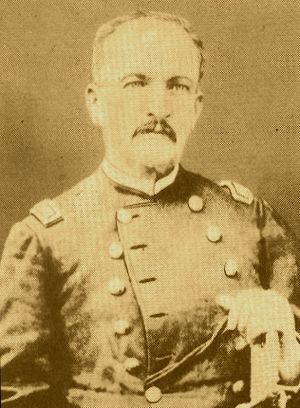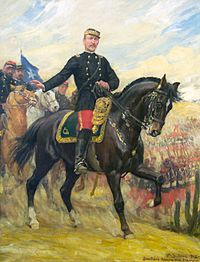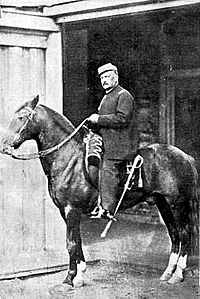Manuel Baquedano facts for kids
Quick facts for kids
Divisional General
Manuel Baquedano
|
|
|---|---|
 |
|
| Accidental Chief of the Republic | |
| In office August 29, 1891 – August 31, 1891 |
|
| Preceded by | José Manuel Balmaceda |
| Succeeded by | Jorge Montt |
| Personal details | |
| Born | January 1, 1823 Santiago, Chile |
| Died | September 30, 1897 (aged 74) Santiago, Chile |
| Military service | |
| Battles/wars | War of the Confederation
Revolution of 1851
|
Manuel Jesús Baquedano González (born January 1, 1823 – died September 30, 1897) was a brave Chilean soldier and important politician. He served as the Commander-in-Chief of the Army during the War of the Pacific. He was also briefly the President of Chile during the civil war of 1891.
Manuel Baquedano came from a Spanish family. He fought in many important wars and revolutions. These included the War of the Confederation, the revolutions of 1851 and 1859, and the Occupation of Araucanía. He also played a key role in the War of the Pacific. Besides his military career, he was a Senator for Santiago and Colchagua. He helped make the Army stronger and set up the Military Academy.
Contents
Early Life and First Battles
Manuel Baquedano was born in Santiago. His father, Fernando Baquedano, was a cavalry colonel. Manuel studied at the Instituto Nacional of Chile. There, he became good friends with Federico Errázuriz Zañartu and Eusebio Lillo.
When the War of the Confederation started in 1838, Manuel was only 15. He left school to join the army. He fought in the Battle of Yungay in 1839. At just 16 years old, he was promoted to Lieutenant on the battlefield.
Military Career and Revolutions
After returning to Chile, Manuel Baquedano continued his military training. He became a regular Lieutenant in 1845. By January 1850, he was promoted to full Captain.
Role in the 1851 Revolution
During the Revolution of 1851, Manuel Baquedano was very important. He helped stop troops who rebelled against the election of Manuel Montt as president. These rebels were led by Colonel Pedro Urriola. Later, he fought in the government forces at the battle of Loncomilla. This was a difficult battle because his own father and brother were fighting on the other side. After the battle, he asked to visit his wounded father.
In 1852, Manuel Montt promoted him to sergeant-major of the government bodyguard.
Taking a Break from the Army
In 1854, Baquedano lost his job as military commander of Angol. This happened after a confusing incident at the barracks. He then decided to leave the army. With his savings, he bought a small farm called Santa Teresa near Los Angeles.
However, the government did not accept his resignation. They appointed him to a military position in Valparaíso in 1855. Later, he moved to Arauco to be closer to his farm. For about 14 years, from 1855 to 1869, he focused on making his farm successful. He became quite wealthy from it.
Returning to Active Service
Baquedano returned to the army in June 1859. The government called him back to stop a rebellion in Concepción. For his help, he was promoted to regular sergeant major. Seven years later, in 1866, he became a lieutenant-colonel. He balanced this role with his farming work.
In 1868, the Army needed him again for the Occupation of Araucanía. He helped fight against the Mapuche chiefs, like Quilapán. From January to May 1869, he took part in many battles in Malleco and Renaico. Because of his service, he was given command of the Cazadores a Caballo cavalry regiment. This was the same position his father had held. He was transferred to Santiago. He continued to rise through the ranks, becoming a colonel in 1870 and a brigadier-general in 1876. He also served as inspector-general of the National Guard. His military service and strong personality made him well-known.
Leading in the War of the Pacific
| "An Army, like ours, shaped by self-denial, patriotism, and great civic virtues could not be defeated; it is an army of citizens transformed into lions consorting with victory. If we have won, we owe it to our soldiers and to our citizens." |
| General Manuel Baquedano's victory speech, April, 1881. |
When the War of the Pacific began in April 1879, Baquedano was the general in charge of the cavalry. In November 1879, he landed his troops in Pisagua. This was a very important move, seen as the first amphibious landing in history.
He took part in the first three major land campaigns: Tarapacá, Tacna and Arica, and Lima. He also planned the Battle of Los Ángeles. After General Erasmo Escala resigned, Baquedano was chosen as Commander-in-Chief. People hoped he would bring order and good spirits back to the troops.
Baquedano's military fame grew because of his excellent leadership. He played a key role in the battles of Chorrillos and Miraflores in January 1881. Thanks to his soldiers' efforts, the Peruvian capital was occupied in less than a month.
Baquedano returned to Chile in March 1881. The government decided to bring most of the army home because it was too expensive to keep them in Peru. He received a huge welcome in Valparaiso and Santiago.
Baquedano's Generalship Style
Baquedano's main military plan was to attack the enemy head-on. Even though he didn't have much training in strategy, he is remembered as a general who personally led battles that resulted in big wins. He was very strict. Once he made a decision, he would not change his mind.
After the Battle of Tacna, a newspaper criticized his tactics. Baquedano was so angry that he had the reporter arrested. Historian Francisco Antonio Encina said Baquedano was brave but lacked new ideas. However, even his rivals agreed that his orders helped win the Battle of Miraflores.
Later Life and Legacy
Baquedano retired from the military in May 1881. He was offered the chance to run for president twice, but neither campaign went far. In 1881, the government gave him lifelong honors and pay as a commander-in-chief.
He was elected as a senator for Santiago for two terms (1882-1888). Then he served as a senator for Colchagua for another two terms (1888-1894). As a senator, he helped reorganize the Army. He was part of the group that set up the General Staff and the military academy. In 1889, President José Manuel Balmaceda sent him on a trip to Europe. When he returned in 1890, he was again offered the chance to run for president, but he refused.
During the 1891 Chilean Civil War, Baquedano did not pick a side. However, after Balmaceda's forces lost the battle of La Placilla, Balmaceda knew he could no longer stay in power. On August 29, 1891, Balmaceda officially gave power to General Baquedano. Baquedano tried to keep order in Santiago until the new leaders arrived. On August 31, he handed power to Navy captain Jorge Montt and retired for good.
Manuel Baquedano died at his home in Santiago on September 30, 1897, at 74 years old.
Memorials and Tributes

There is a statue of Baquedano on horseback in Plaza Baquedano in Santiago.
Several places in Chile are named after him:
- Baquedano metro station in Santiago.
- Plaza Baquedano in Santiago.
- Baquedano Street in Iquique.
- The Cordón Baquedano mountain range in Chilean Tierra del Fuego.
Two ships of the Chilean Navy have also been named in his honor: the frigate General Baquedano (PF-09) and the corvette Baquedano (1898).
As of March 12, 2021, the statue in Plaza Baquedano was removed due to ongoing damage.
See also
 In Spanish: Manuel Baquedano para niños
In Spanish: Manuel Baquedano para niños



